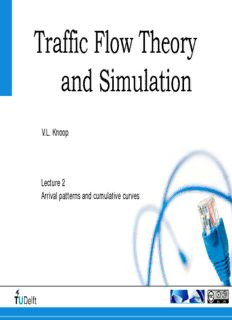
Arrival Patterns and Cumulative Curves PDF
Preview Arrival Patterns and Cumulative Curves
Traffic Flow Theory and Simulation V.L. Knoop Lecture 2 Arrival patterns and cumulative curves Arrival patterns From microscopic to macroscopic 24-3-2014 Delft University of Technology Challenge the future Recap traffic flow variables Microscopic Macroscopic (vehicle-based) (flow-based) Space headway (s [m]) Density (k [veh/km]) Time headway (h [s]) Flow (q [veh/h]) Speed (v [m/s]) Average speed (u [km/h]) s=h*v q=k*u Lecture 2 – Arrival patterns 3 | 32 Excercise– a task for you! • What is the average speed if you travel • 10 km/h from home to university • 20 km/h on the way back • What is the average speed if you make a trip with speed • v1 on the outbound trip • v2 on the inbound trip • What is the average speed if you split the trip in n equidistant sections, which you travel in v i Lecture 2 – Arrival patterns 4 | 32 Similar problems arise in traffic • Local measurements, spatial average speed needed • Weigh speed measurements • Inversely proportional to speed Lecture 2 – Arrival patterns 5 | 32 The math… • Weigh speed measurements (w) • Inversely proportional to speed: wi=1/vi Time-average of pace (1/v) Lecture 2 – Arrival patterns 6 | 32 … and the effect What is higher time mean speed (A) or space mean speed (B)? Lecture 2 – Arrival patterns 7 | 32 Summary • Speed averaging is not trivial • Obtain time mean speed from loop detector data by harmonic average (i.e., averaging 1/v) • Space mean speed is lower, with differences in practice up to factor 2 Lecture 2 – Arrival patterns 8 | 32 Overview of remainder of lecture • Arrival process and relating probability distribution functions • Poisson process (independent arrivals) • Neg. binomial distribution and binomial distribution • Applications facility design (determine length right- or left-turn lane) • Time headway distributions • Distribution functions and headway models • Applications • Speed distribution and free speed distributions Lecture 2 – Arrival patterns 9 | 32 Arrival processes • Insight into probability distribution of the number of vehicles arriving in a short time interval (e.g. 15 seconds) is important for several applications Example: No blocking back Blocking back due to extra lane due to extra lane – Length of extra lane for left-turning vehicles at an intersection – Probability that queue exceeds roadway space is limited (e.g. 5%) Models for the distribution of vehicles arriving in a short period of time – Poisson process – Binomial process Arrival – Negative binomial process location x Lecture 2 – Arrival patterns 10 | 32
Description: